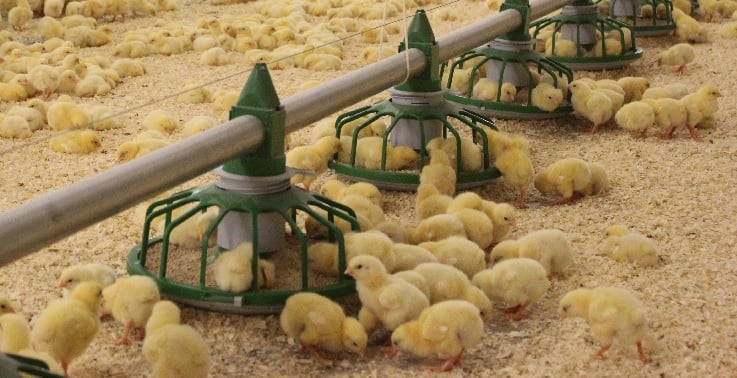"I was once in a house with 5% broiler mortality. You often see that in periods of high demand in the market for hatchery eggs, eggs are being supplied that are too lightweight. This has a direct correlation to the lighter weight of the broilers and a higher risk of broiler mortality.”
Wim Peters is a Poultry Specialist with 30 years+ of experience working at Vencomatic Group, he regularly advises broiler farmers across the globe regarding how to prevent broiler mortality.
- Design of house
'"Thriving broilers means thriving business for the farmer. Already in the design phase of a barn, the amount and positions of feeding pans and drinking nipples need to be taken very seriously as they are crucial to the success of the broilers and minimising mortality rates. And not to forget a good lighting system as this allows the broilers to find the locations where water and feed are available, otherwise, mortality is inevitable."
- Feed & water
"Feed and certainly water must be available in sufficient quantities and contain the right nutrients: proteins, vitamins, and minerals like calcium and phosphorus. These minerals are essential for good bone development at the right speed and with the right density/strength. Good quality feed will help to develop good quality meat."
- Weight of hatching eggs
For example, we know that when hatching eggs are too light in weight this can directly impact the mortality rate of broilers. "50 grams is the minimum. Hatching eggs that weigh below this minimum weight usually result in smaller chicks. These smaller chicks on average have a higher mortality rate. You can easily calculate the estimated weight of a broiler based on the weight of the egg.

So if you have an egg of 60 grams x 2 = 120 grams/ 3 = 40 grams + 1 = the estimated weight, in this case the chick will be 41 grams. You can imagine that if you have an egg of <50 grams, the mortality rate will go up. Having eggs and therefore broilers of more or less the same weight also helps to control the growth rate of the individual broilers. If the weight of the broilers is very varied, the smallest chicks are most likely not going to survive, whilst the larger ones might grow too fast. The more consistent the egg weight, the more consistent the weight of your chicks and the, more consistent you can raise them.
- Growth rate
“Another main cause of death in broilers is when they grow so fast the heart can’t keep up anymore, they call them ‘death growers’. So controlled balance is important. Working with feed and light schedules will help you to monitor and manage their growth rate or even slow it down. In some countries, there is even legislation in place stating that a broiler is only allowed to grow a maximum of 50 grams per day."
- Climate
"The temperature in the house is critical. One-day-old chicks, start at 95⁰F (35⁰C) as they are still quite naked they need external heat to stay warm. As the chick grows and they get their fluffy feather coat they are much better able to regulate their body temperature. The temperature in the house can go down to about 68⁰F (20⁰C). In our Patio system, the chicks are generating so much heat that already after a week you don't need to add heat from external sources anymore. As a matter of fact, you need to find ways to remove this metabolic heat from the chicks.“
- Moisture
"Fresh air and the removal of moisture from the air are essential to creating an optimal climate in the broiler house. Animals and people breathe out water vapor (H2O) you need to keep this to a minimum. It is even one of the reasons why farmers get so-called 'wet pens' in the autumn as the litter will be too damp. What you often see is that ventilation gets reduced when the outside temperatures go down. However, reducing ventilation means that less water vapor can get out of the house leading to damper litter. For the animals, this means they are walking around on a wet substrate that makes them feel uncomfortable and can even lead to diseases and in the worst case death. There are ways to control the outside and inside climate and prevent these wet houses by installing a heat exchanger ventilation. Our ECO Unit is a heat exchanger which significantly reduces the moisture within the house, ensuring drier litter. An additional benefit of the ECO Unit is that you only require a minimum amount of fossil fuels, significantly lowering your gas bills!
- Diseases & hygiene management
"Diseases are, of course, a major cause of death. You have to vaccinate broilers at regular times and based on local policies. Hygiene precaution management is also important as it will help to keep diseases at bay. Good hygiene protocols mean you are limiting the opportunities for diseases. Think of no unnecessary visitors, no pets in the house, regular pest controls, and ensuring your staff uses clean working clothes and even showering before entering.
Success in reducing the mortality rate
"If you have a mortality rate of less than 1% after the first week, you are doing well. If mortality increases later on and you have taken all the above factors into account, you might want to talk to the hatchery. The mortality rate might not be due to conditions that you could have controlled but might have come with the quality of the hatching eggs you received. Someone once compared a broiler to a tightrope walker: if everything is perfect, she goes straight across the rope and gets to the other side smiling. But if one thing goes wrong..."
Read the whitepaper to discover more about the important factors for optimal wellbeing of broilers and maximizing value for farmers.












.png?width=160&height=132&name=Egg%20packers%20-%20Vencomatic%20Group%20(2).png)
.png?width=160&height=132&name=Meggsius%20Select%20-%20Vencomatic%20Group%20(2).png)












